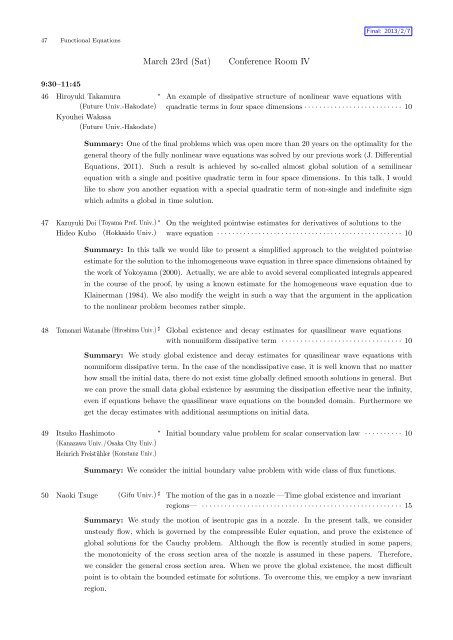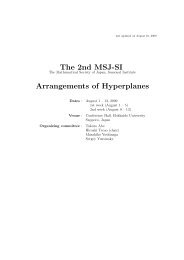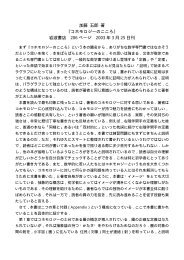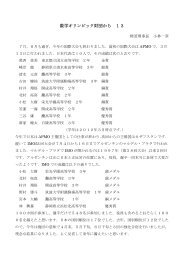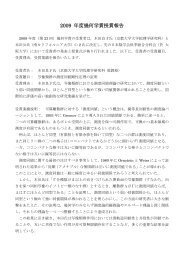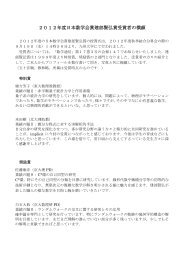Titles and Short Summaries of the Talks
Titles and Short Summaries of the Talks
Titles and Short Summaries of the Talks
Create successful ePaper yourself
Turn your PDF publications into a flip-book with our unique Google optimized e-Paper software.
47 Functional Equations<br />
9:30–11:45<br />
March 23rd (Sat) Conference Room IV<br />
Final: 2013/2/7<br />
46 Hiroyuki Takamura<br />
∗ An example <strong>of</strong> dissipative structure <strong>of</strong> nonlinear wave equations with<br />
(Future Univ.-Hakodate)<br />
Kyouhei Wakasa<br />
(Future Univ.-Hakodate)<br />
quadratic terms in four space dimensions · · · · · · · · · · · · · · · · · · · · · · · · · · 10<br />
Summary: One <strong>of</strong> <strong>the</strong> final problems which was open more than 20 years on <strong>the</strong> optimality for <strong>the</strong><br />
general <strong>the</strong>ory <strong>of</strong> <strong>the</strong> fully nonlinear wave equations was solved by our previous work (J. Differential<br />
Equations, 2011). Such a result is achieved by so-called almost global solution <strong>of</strong> a semilinear<br />
equation with a single <strong>and</strong> positive quadratic term in four space dimensions. In this talk, I would<br />
like to show you ano<strong>the</strong>r equation with a special quadratic term <strong>of</strong> non-single <strong>and</strong> indefinite sign<br />
which admits a global in time solution.<br />
47 Kazuyuki Doi (Toyama Pref. Univ.) ∗ On <strong>the</strong> weighted pointwise estimates for derivatives <strong>of</strong> solutions to <strong>the</strong><br />
Hideo Kubo (Hokkaido Univ.) wave equation · · · · · · · · · · · · · · · · · · · · · · · · · · · · · · · · · · · · · · · · · · · · · · · · · 10<br />
Summary: In this talk we would like to present a simplified approach to <strong>the</strong> weighted pointwise<br />
estimate for <strong>the</strong> solution to <strong>the</strong> inhomogeneous wave equation in three space dimensions obtained by<br />
<strong>the</strong> work <strong>of</strong> Yokoyama (2000). Actually, we are able to avoid several complicated integrals appeared<br />
in <strong>the</strong> course <strong>of</strong> <strong>the</strong> pro<strong>of</strong>, by using a known estimate for <strong>the</strong> homogeneous wave equation due to<br />
Klainerman (1984). We also modify <strong>the</strong> weight in such a way that <strong>the</strong> argument in <strong>the</strong> application<br />
to <strong>the</strong> nonlinear problem becomes ra<strong>the</strong>r simple.<br />
48 Tomonari Watanabe (Hiroshima Univ.) ♯ Global existence <strong>and</strong> decay estimates for quasilinear wave equations<br />
with nonuniform dissipative term · · · · · · · · · · · · · · · · · · · · · · · · · · · · · · · · 10<br />
Summary: We study global existence <strong>and</strong> decay estimates for quasilinear wave equations with<br />
nonuniform dissipative term. In <strong>the</strong> case <strong>of</strong> <strong>the</strong> nondissipative case, it is well known that no matter<br />
how small <strong>the</strong> initial data, <strong>the</strong>re do not exist time globally defined smooth solutions in general. But<br />
we can prove <strong>the</strong> small data global existence by assuming <strong>the</strong> dissipation effective near <strong>the</strong> infinity,<br />
even if equations behave <strong>the</strong> quasilinear wave equations on <strong>the</strong> bounded domain. Fur<strong>the</strong>rmore we<br />
get <strong>the</strong> decay estimates with additional assumptions on initial data.<br />
49 Itsuko Hashimoto<br />
(Kanazawa Univ./Osaka City Univ.)<br />
Heinrich Freistühler (Konstanz Univ.)<br />
∗ Initial boundary value problem for scalar conservation law · · · · · · · · · · 10<br />
Summary: We consider <strong>the</strong> initial boundary value problem with wide class <strong>of</strong> flux functions.<br />
50 Naoki Tsuge (Gifu Univ.) ♯ The motion <strong>of</strong> <strong>the</strong> gas in a nozzle —Time global existence <strong>and</strong> invariant<br />
regions— · · · · · · · · · · · · · · · · · · · · · · · · · · · · · · · · · · · · · · · · · · · · · · · · · · · · · 15<br />
Summary: We study <strong>the</strong> motion <strong>of</strong> isentropic gas in a nozzle. In <strong>the</strong> present talk, we consider<br />
unsteady flow, which is governed by <strong>the</strong> compressible Euler equation, <strong>and</strong> prove <strong>the</strong> existence <strong>of</strong><br />
global solutions for <strong>the</strong> Cauchy problem. Although <strong>the</strong> flow is recently studied in some papers,<br />
<strong>the</strong> monotonicity <strong>of</strong> <strong>the</strong> cross section area <strong>of</strong> <strong>the</strong> nozzle is assumed in <strong>the</strong>se papers. Therefore,<br />
we consider <strong>the</strong> general cross section area. When we prove <strong>the</strong> global existence, <strong>the</strong> most difficult<br />
point is to obtain <strong>the</strong> bounded estimate for solutions. To overcome this, we employ a new invariant<br />
region.


